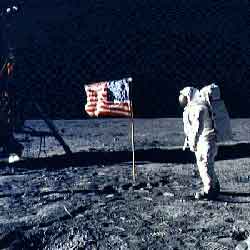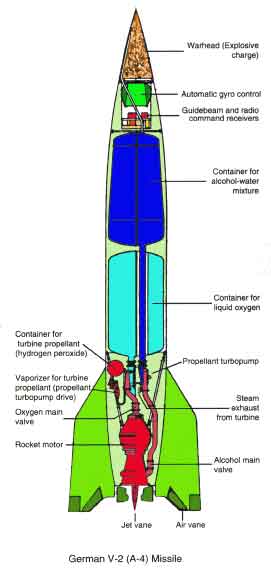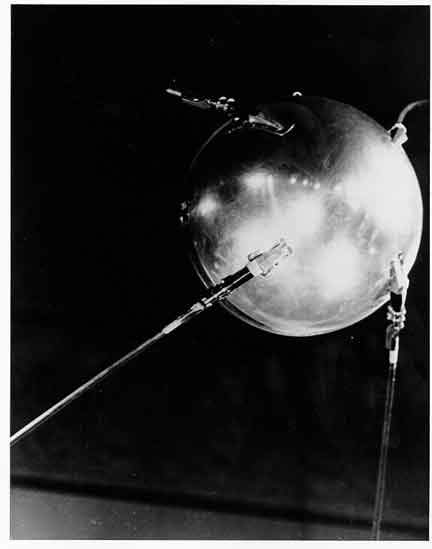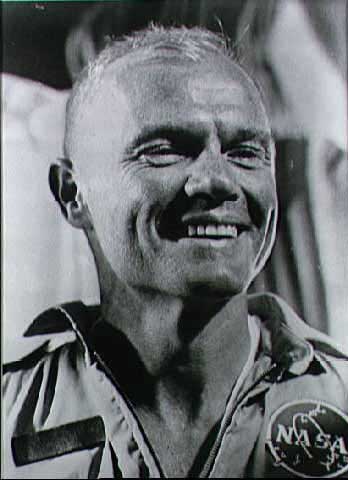The History of Rockets

Index
Rockets In Ancient times
The first rocket like device was invented around 100BC by a greek named Hero of Alexandria. This device was called an aeolipile. It consisted of a sphere mounted on a water kettle. A fire beneath the kettle turned the water to steam, which then traveled through pipes to the sphere and was expelled through two L-shaped pipes that caused the sphere to rotate.

When rockets as we know them were first invented is not known. The first date we know true rockets were used was the year 1232, however it is believed possible that the Chinese had primitive rocket like devices before this. At this time the Chinese were at war with the Mongols. During one of the battles, the battle of Kai-Keng, the Chinese managed to repel the Mongol invaders by using "arrows of flying fire." These fire-arrows were a simple form of a solid-propellant rocket. A tube, capped at one end, was filled with gunpowder. The other end was left open and the tube was attached to a long stick. When the powder was ignited, the rapid burning of the powder produced fire, smoke, and gas that escaped out the open end and produced a thrust. The stick acted as a simple guidance system that kept the rocket headed in one general direction as it flew through the air. It is not clear how effective these arrows of flying fire were as weapons of destruction, but their psychological effects on the Mongols was probably quite large.

There were many reports of rocket experiments all through the 13th to 15 centuries. For instance, "According to one ancient legend, a Chinese official named Wan-Hoo attempted a flight to the moon using a large wicker chair to which were fastened 47 large rockets. Forty seven assistants, each armed with torches, rushed forward to light the fuses. In a moment there was a tremendous roar accompanied by billowing clouds of smoke. When the smoke cleared, the flying chair and Wan-Hu were gone." (Copied from http://history.msfc.nasa.gov/rocketry/tl1.html) In England, a monk named Roger Bacon worked on improved forms of gunpowder that greatly increased the range of rockets. In France, Jean Froissart found that more accurate flights could be achieved by launching rockets through tubes. Froissart's idea was the forerunner of the modern bazooka. Joanes de Fontana of Italy designed a surface-running rocket-powered torpedo for setting enemy ships on fire. In 1650, a Polish artillery expert, Kazimierz Siemienowicz, published a series of drawings for a staged rocket.
During the early introduction of rockets to England, rockets were used primarily for war. Many battles were fought where rockets played important roles. Francis Scott Key coined the phrase the "rocket's red glare" after the British fired Congreve rockets against the United States in the War of 1812. Congreve had used a 16-foot guidestick to help stabilize his rocket. William Hale, another British inventor, invented the stickless rocket in 1846. The U.S. army used the Hale rocket more than 100 years ago in the war with Mexico. Rockets were also used to a limited extent in the Civil War.
The 19th century became a time of expirimentation with rockets. During the 19th century, rocket enthusiasts and inventors began to appear in every country. They met with a mixed reaction. Some thought these inventors were geniuses, while others thought they were crazy. An Italian living in Paris by the name of Claude Ruggieri apparently rocketed small animals into space as early as 1806. French authorities were not always impressed with his experiments though. They halted his attempt to launch a small boy using a rocket cluster. Rockets were also used in hunting. As far back as 1821, rocket propelled harpoons were used to hunt whales. They were launched from a shoulder held tube equipped with a circular blast guard. By 1870, American and British inventors had found other ways to use rockets. For example, the Congreve rocket was capable of carrying a line to a stranded ship. In 1914, an estimated 1,000 lives were saved by this technique.
The Birth Of Modern Rocketry
Modern Rocketry really got started in 1903, when a Russian school teacher by the name of Tsiolkovsky published a report suggesting the use of liquid propelants in rockets to increase the range of the rockets. He stated that "the speed and range of a rocket were limited by the exhaust velocity of escaping gases." For his ideas, careful research, and great vision, Tsiolkovsky has been called the father of modern astronautics.
The first liquid fuel rocket was developed and launched by an American named Robert H. Goddard in 1926. Robert also came up with many other ideas essential to modern rocketry. In 1919 he published a phamplet entitled a method for Reaching Extreme Altitudes. In this phamplet he stated that rockets operate with greater efficiency in a vacuum than in air, an idea that he was much laughed at for. At the time, people believed that a rocket operated by pushing against air. Goddard also stated that multistage or step rockets were the answer to achieving the high altitudes and speeds needed to escape earth's gravity.

Goddard continued his rocket experiments for many years. In this time he developed several different advancements in rocket technology, including a gyroscope steering system and a payload compartment for scientific instruments. Goddard, for his achievements, has been called the father of modern rocketry.
In 1937, a group German engineers and scientists assembled on the shores of the Baltic Sea in Peenemunde . There, under the directorship of Wernher von Braun, they developed most advanced rocket of its time, the German V-2 Missile .

By comparison to todays standards, the V-2 rocket was small. It used a mixture of Liquid Oxygen and Alcohol, which it burned at a rate of about one ton every seven seconds to achieve its thrust. Once launched, the V-2 was a very formidable weapon that could destroy whole city blocks. Fortunately for the allied forces, the rocket was developed too late in the war to change its outcome. When Germany fell, many unused V-2 rockets and parts were captured by the allies. In addition, many German Rocket scientist surrendered to the United States, fearing for their lives if they remained in Germany. In particular, Wernher von Braun, the director of the V-2 project. His surrender to the US would contribute greatly to the eventual winning of the space race. Others went to the Soviet Union. This was a major factor when the space race got underway. The potential of rockets as weapons was realized by both the United States and the Soviet Union, and a variety of missiles was developed by both sides.
The Space Race
On October 4, 1957 The Soviet Union launched the first Earth-orbiting artificial sattelite and stunned the world. This satelite, called Sputnik I, was the start of the race for space between the US and the Soviet Union. Less than a month later, the Soviets followed their success with the launch of a satelite with a dog named Laika aboard. Laika survived in space for seven days before the oxygen ran out.

Sputnik 1
A few months after the launch of sputnik, the US launched a satelite of its own. On January 31,1958 Explorer I was launched by the US Army. In October first of that year, the US formally organized its space program by creating the National Aeronautics and Space Administration (NASA). NASA became a civilian agency with the proclaimed goal of peaceful exploration of space for the benefit of all humankind. However, at this point in history most explorations of space were primarily military in nature.
The next few years were a time of many advancements in rocketry for both the US and the Soviet Union. On April 12, 1961, the Soviet Union scored another first with the launch of the first man in to orbital flight, Yuri Gangarin. The United States began Project Mercury. It was designed to place a manned capsule into earth orbit, study his reactions to the environment, and recover both the capsule and the pilot safely. On May 5th, 1961, the Freedom 7 spacecraft was launched with American astronaut Alan Shepard aboard. It made a 15-minute sub-orbital flight, marking the first American in space.

Alan Shepard
On February 20, 1962 the Friendship 7 spacecraft was launched from the Kennedy Space Center in Florida with American Astronaut John Glenn aboard. He piloted the spacecraft in three orbits of the earth, lasting four hours, fifty-five minutes and twenty three seconds. This historic event marked the first American to orbit the earth.

John Glenn
In 1961, NASA and other organizations had undertaken the challenge to put a man on the moon. This was the beginning of the Apollo project. In 1968 America achieved its initial first of the space race with the launch of Apollo 8. It was launched from the Kennedy Space center on December 21,1968 atop a Saturn V booster with three American astronauts aboard: Frank Borman, James A. Lovell, Jr., and William A. Anders. After one and a half earth orbits, Apollo 8 burned for the moon. On December 24-25, they successfully orbited the moon, then proceded to return to earth and land on December 27. Not only was this the first maned flight to orbit the moon, it also rekindled the public excitement for the space program and set the stage for the moon landing.

The crew of Apollo 8 with their spacecraft in the background. Courtesy of NASA
The crowning achievement of the space program occurred on July 20, 1969. On July 16, 1969 at 09:32:00 am EDT, Apollo 11 lifted off from pad 39-A at the Kennedy Space center, Fl. Over the next three days Apollo 11 approached the moon and entered into orbit. At 4:18 p.m. EST on July 20, 1969 the lunar module, containing American astronauts Neil A. Armstrong and Edwin E. Aldrin, touched down, and man took his first steps on the moon. America had won the space race.

The Apollo 11 crew:Neil A. Armstrong
commander
Michael Collins
command module pilot
Edwin E. Aldrin Jr.
lunar module pilot.
Rockets in recent times
In the years since the space race was over, we have continued to make advances in space and rocket science. On March 16, 1966 the Gemini VIII mission completed the first docking in space. On December 15, 1970, the Soviet Union's Venera 7 transmitted data from the surface of Venus. On June 7, 1971 the Soviet Salyut 1 was boarded by Soviet cosmonauts, making it the first manned space station. And on April 12, 1981, the Space Shuttle Columbia, first of its breed, lifted of with a crew of 2.
Rocket science will continue to advance. New methods of propulsion are being developed that will allow people to go farther, faster. New styles of aircraft are in the works that will allow quick and easy access to space. How far we will go, only time will tell.








